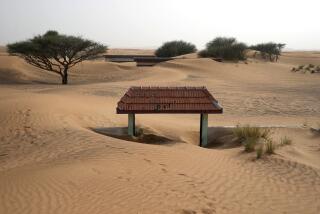Spice Island Development Plan : Zanzibar Acts to Gentrify Site of Once-Lavish Homes
- Share via
ZANZIBAR, Tanzania — More than a century after Arab slave traders and gold and ivory merchants built their lavish homes, shops and bazaars near Zanzibar’s flourishing harbor, the labyrinthine old quarter is crumbling.
Now, the government is trying to restore the district known as Stone Town to at least a semblance of its former glory through a process very similar to the gentrification of run-down neighborhoods in England and the United States.
Commercial Focal Point
Stone Town never ceased to be a commercial focal point for the Spice Island. Its elaborately carved, brass-studded wooden doors and the lattice-work balconies hanging over narrow alleys embody Zanzibar’s intertwined Arab, Asian and African heritage.
During 20 years of social and economic upheaval, Stone Town was neglected and suffered severe deterioration. But with new money created by the government’s 5-year-old policy of economic liberalization and $400,000 in technical assistance from the United Nations, Zanzibar hopes to reverse the decay.
The effort is led by Ahmed Sheik Ahmed, director of the Stone Town Conservation and Development Authority, which has put most of its resources not into renovating the buildings but selling them.
“The idea of selling the buildings is not to get money, the idea is to get people to look after the buildings,” said Ahmed.
After a revolution by Zanzibar’s black majority in 1964, many of their abandoned buildings were confiscated by the socialist government, which converted them into multifamily dwellings for low-income families and newly arrived rural peasants.
Potential Danger Seen
Many of the dilapidated structures now pose a potential danger to tenants and shoppers in the quarter’s busy alleys, said Ahmed. During heavy rains in 1984, seven buildings collapsed, killing five people, he said.
Stone Town is home to an estimated 18,000 people.
It is Zanzibar’s historic seat of government and still houses most of the island’s official offices, 40% of the city’s classrooms, the majority of its mosques, temples and churches, as well as banks, movie houses, hotels, restaurants and the island’s main market.
It contains the remains of a stone fort built by Omani Arabs in the 1700s, a palace built by the island’s Arab rulers in the middle 19th Century, the home of Tippu Tub, a notorious slave trader, and other historically or architecturally valuable buildings.
Since 1985, the development authority has overseen the sale of 120 buildings, and Ahmed credited the sales to the nation’s economic liberalization policies that opened doors to free enterprise.
“Before 1984, most shops were closed. After 1984, most shops opened. Now they can do business, make money and repair buildings,” Ahmed said.
More to Read
Sign up for Essential California
The most important California stories and recommendations in your inbox every morning.
You may occasionally receive promotional content from the Los Angeles Times.












